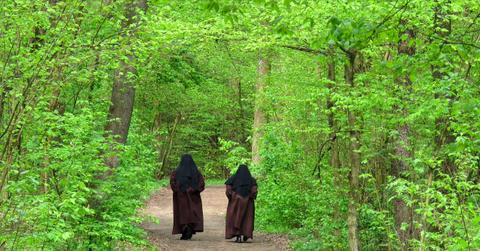How Nuns Are Fighting For The Environment
"Green sisters" are helping to save endangered species and blocking pipelines with makeshift chapels.
Updated May 31 2019, 12:28 p.m. ET
What does an environmentalist look like? If you’re reaching for stereotypes, an environmentalist looks “crunchy,” the type who wraps their wild hair in a dingy bandana and stomps around in old Birkenstocks, a steel water bottle clattering around in the burlap bag on their shoulder.
Of course, it’s not as simple as all that. Environmentalists are young and old, male and female, self-identified hippies and credentialed scientists. They don’t all rock organic cotton T-shirts, either — in fact, some wear starched black habits.
Nuns have increasingly become champions of the natural world, and that doesn’t just mean adding solar panels to their convents. They’re working with conservationists to save the endangered Lake Pátzcuaro salamander. They’re holding prayer vigils outside landfills. And when energy companies announce pipeline plans, they’re building makeshift chapels right in their paths.
“Religious communities come into existence because of a cultural or political or historical urgency,” Sister Gail Worcelo told The Atlantic. “Sisters have addressed urgencies for education, or for a reconstitution of a life of prayer. And in our time, we see this urgency — the urgency is planetary.”
While the number of nuns has been declining for decades — especially in the U.S., where numbers have dropped from 180,000 in 1965 to roughly 50,000 in 2014 — the sisters that remain are particularly vocal about conservation and sustainability. Some draw inspiration from the current Vatican leader, Pope Francis, who released a 184-page papal encyclical (basically, a very long letter) in 2015 calling on Catholics to “care for our common home.” The encyclical directly spurred Sister Mary Elizabeth Clark, for one, to write a children’s book teaching practical lessons on rain barrels and terrariums. Teaching Kids to Care for God’s Creation was published earlier this year.
But other nuns think the eco impulse is much older, baked right into the doctrines they preach about the beauty of creation and seeking fulfillment outside material goods. “There’s a freedom in living simply,” Sister Kathy Wright told STIR. “It’s not all about deprivation, doing without, whatever. I think to the extent that we can continue to model an alternative that is joyful… then I think there’s real hope.”
Nuns have a long history of activism, even within the environmental space. Sister Dorothy Stang is perhaps the most famous face of the movement, an American nun who advocated for the Brazilian rainforests and poor farmers before her death in 2005.
So-called “green sisters” are continuing her work through visible protest as well as quieter forms of action, like maintaining farms or “shareholder activism,” whereby nuns, like Sister Nora Nash of the Sisters of St. Francis of Philadelphia, use corporate investments to make their voices heard.
“We want social returns, as well as financial ones,” she explained to The New York Times. “We’re not here to put corporations down. We’re here to improve their sense of responsibility.”
Through all these actions, religious women are pushing for change — and proving that you can find environmentalists even in cloistered convents.
